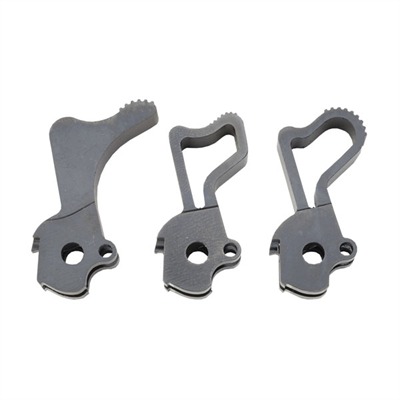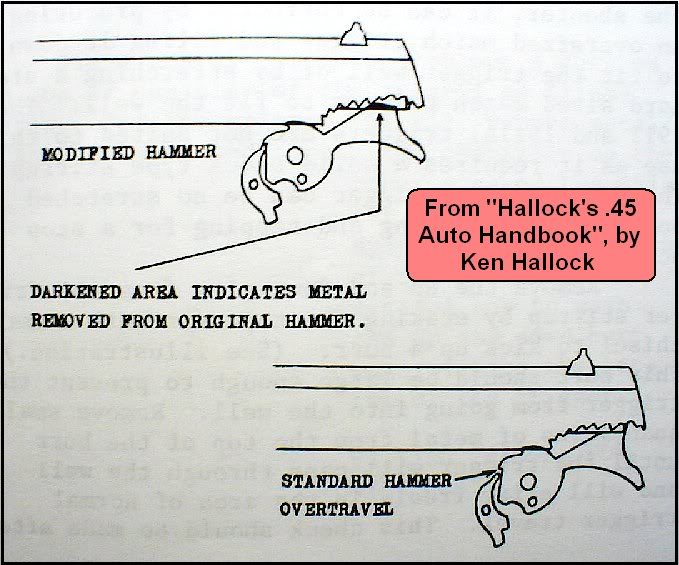Hammer Design
original:
forum.m1911.org
Retrieved: November 23, 2011
Last Post: February 20, 2011
Noelsidewinder
19th February 2011
I have noticed, if it is not my imagination, that there seem to be a lot of
variations on the 1911a1 hammer design; in respect to the length and shape of
the striking face. It would seem that some of the new design hammers have
different lengths measured from the hammer pin hole center to their upper
edge. Also, some are straight while others seem to have a "cam" end design.
Can anybody explain the reasons behind these variations and if they have an
inter relation with the sear/hammer engagement?
And more importantly, do they have an effect of easing and smoothing or even
reducing the slide recoil effect?

Hawkmoon
19th February 2011
Those all look flat/straight to me, and the length looks about the same, as
well. What is this photo supposed to be showing?
Noelsidewinder
19th February 2011
The hammer on the left seems to show a slightly different length and top
radius (cam).
BigJon
19th February 2011
Design only, by the time the hammer is cocked the upper cam area will not be
touched.
niemi24s
19th February 2011
Quote:
The hammer on the left seems to show a slightly different length...
With that image copied and two parallel lines drawn (one through the pin hole
centers, the other through the upper limits of the faces of the two on the
right) the hammer on the left does certainly seem to have a longer face. Or
the two on the right could be said to have shorter faces. That's in comparison
with each other, but it's hard to say how any compare to the Ordnance face
that ends about 0.915" from the pin hole center.
They do appear to be long enough to hit the firing pin.
wjkuleck
19th February 2011
Quote:
They do appear to be long enough to hit the firing pin.
...and that's how long they have to be for function. They are longer so that
you can have a spur (or rowel) with a pleasing shape that's easier on the
thumb.
Or so I imagine.
Dave Waits
19th February 2011
Oh, I thought he was referring to the slight angle you see at the top of
some hammer-faces to ease the slide hit. My Wilson Value-line has one.
niemi24s
19th February 2011
Here's the copy mentioned in Post #9, but with another line added at the top
- my guess on where the face of the hammer on the left ends:
PICTURE 404
egumpher
19th February 2011
Don't forget that the longer the hammer flat the more the hammer pivots back
and unloads the sear. Some 'high grade" hammers attempt shorten the hammer
flat to minimized sear motion.
DuckRyder
19th February 2011
Wait a second, you lost me...
How does the length of the hammer (the upper portion) impact the sear if the
relationship between the notches, hammer pin and hammer strut pin remains
constant?
niemi24s
19th February 2011
Perhaps what Eric is talking about is hammer overtravel (overcocking?), as
illustrated here:

The author (Hallock) states reducing overcocking also reduces the momentum
the hammer can gain from the time it's released by the slide (on its way back
to battery) to the time the hooks contact the sear nose. This would reduce the
impact stress on both.
DuckRyder
19th February 2011
AHH, I see!
The slide did not even enter my mind...
Hawkmoon
19th February 2011
I believe in reality the hammer travels farther than the slide can push it by
contact anyway. The hammer over-travels, then bounces back and impacts the
slide. It is the impact of that upper corner hitting the slide right at the
point where the firing pin safety occurs in Series 80 pistols that accounts
for the damage to some pistols at that point.
I have a very early Para P12.45 that I bought used. I knew the previous owner
had shot it a lot, and after reading a post on this forum about the problem
for another member, I inspected mine and was horrified to discover that the
underside of my slide was badly eroded (or pounded) at that point. I sent the
slide to EGW and they welded it up and recut it, so now it's as good as new.
The point is that a minor difference in the height of the hammer face to the
start of the radius or chamfer actually doesn't mean much of anything.
egumpher
19th February 2011
Quote:
Perhaps what Eric is talking about is hammer overtravel (overcocking?)
Yep... that what I meant to say... thanks Niemi.
niemi24s
19th February 2011
Quote:
I believe in reality the hammer travels farther than the slide can push it
by contact anyway.
How true, because after firing when the slide's going back, the hammer gets
whipped back and actually loses contact with the slide - whacking the bottom
of the disconnector rail when it rotates back the other way as you mentioned.
The idea behind the modification in Post #13 has nothing to do with how far
the hammer goes back when it whips off the slide - it'll get whipped back
until the spur hits the grip safety whether it's modified or not.
But after the hammer regains contact with the slide, the slide stops and then
starts going forward into battery - with the hammer in contact with it. The
idea behind the modification is to reduce the distance the hooks arc through
on their way back down to the sear nose (after the FPS gets forward of the
hammer face).
In other words, while the slide is going forward into battery the
modification will see the hammer overcocked just a little bit - instead of
being overcocked a lot.
Whether it all amounts to a hill of beans, I don't really know. But maybe it
helps the hooks stay on the sear nose - and avoid hammer follow on light pull
triggers?
Noelsidewinder
20th February 2011
niemi24. Thanks for your drawings and comments.
You might be interested in seeing the type of hammer Hallock describes. If
you follow the below link you will see a gun by Jesse E. Harpe along with a
reprint of a April 1942 article from 'The American Rifleman' titled "Revamping
the .45 Colt". In the article he does not mention the hammer modification as
such, but it is plainly visible. The article in itself is very interesting
along with the rest of the thread. The idea behind the modification would seem
to be, besides your mentioned softening of the sear/hammer reset, a smoothing
of the final recoil stage. If you are up to it, it might be interesting for
you to draw an accurate plan, as Hallock's drawing does not seem very precise.
http://www.louderthanwords.us/forum...314&hilit=Harpe
As always thank you for your help.
Return to 1911 Archive